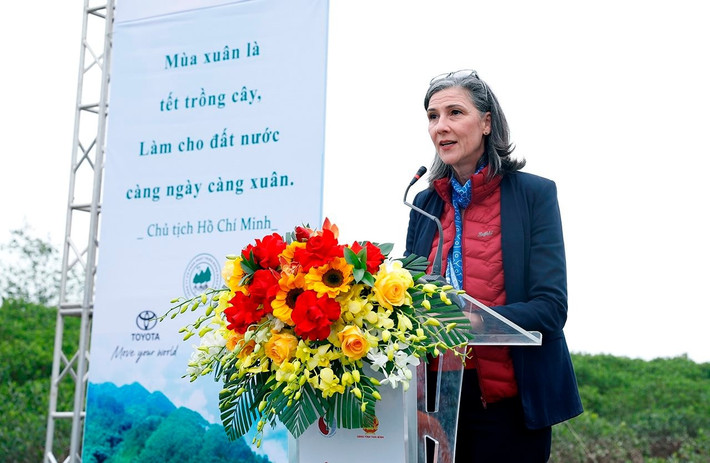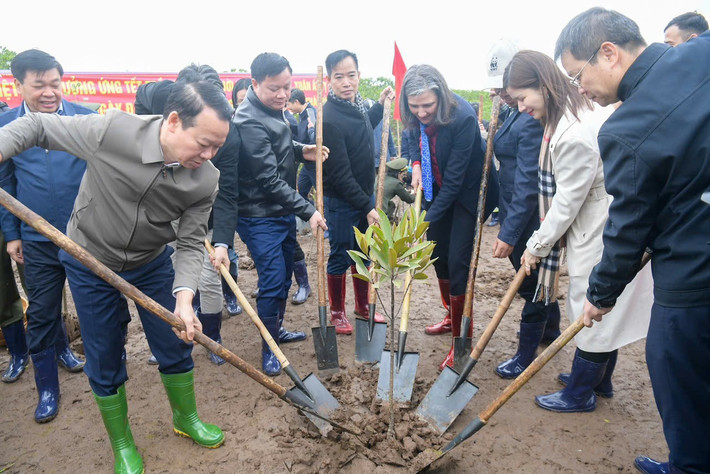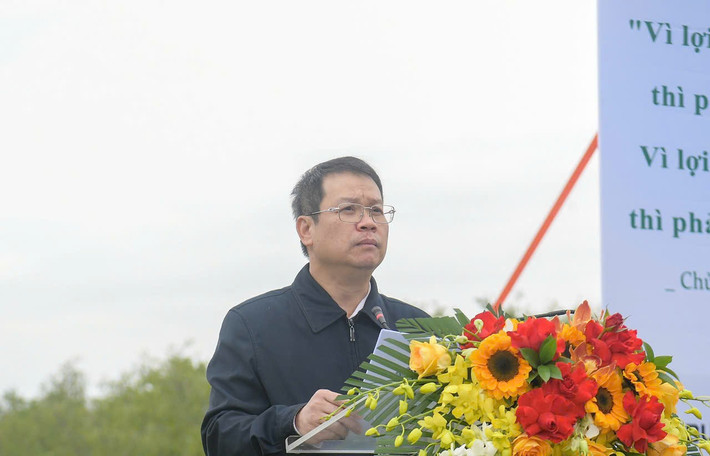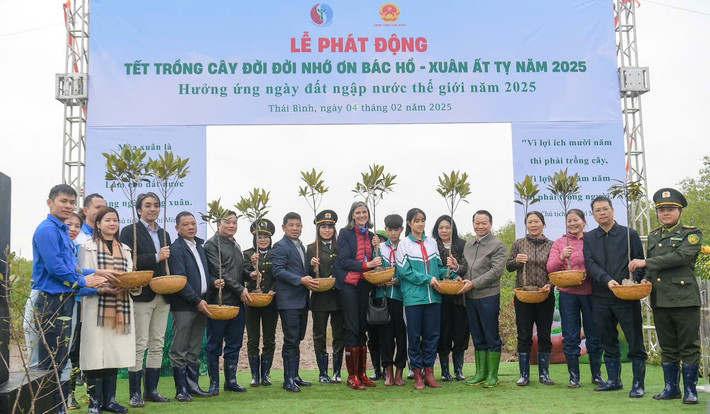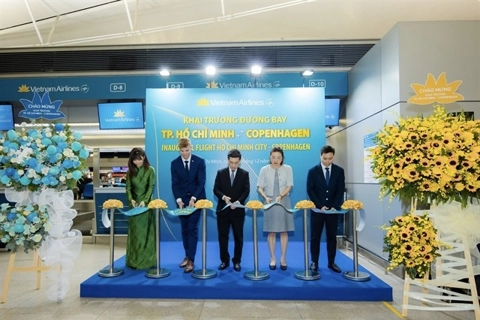Mangrove safeguards Vietnam’s environment
Mangroves are vital to the livelihoods of millions in Vietnam, supplying food, water, and essential resources for sustainable living.
Magroves are considered “climate warriors” in safeguarding our environment and creating a greener and more sustainable Vietnam.
Ramla Khalidi, Resident Representative, UNDP Vietnam, said at the Tree Planting Festival held in Thai Thuy Wetland Nature Reserve in the northern province of Thai Binh on February 4 as part of efforts to celebrate Vietnam’s decades-long spring planting tradition and World Wetlands Day [February 2].
| Ramla Khalidi, Resident Representative, UNDP Vietnam, speaks at the Tree Planting Festival held in Thai Binh Province on February 4. Photos: Vietnamplus/Dai Bieu Nhan Dan |
The festival marked the presence of Do Duc Duy, Minister of the Ministry of Natural Resources and Environment (MONRE); Nguyen Khac Than, Secretary of Thai Binh Party Committee; Nguyen Manh Hung, Chairman of Thai Binh People’s Committee, and residents.
The event initiated a program to plant 10,000 Kandelia candel and Sonneratia caseolaris trees in the 6,560-ha Thai Thuy Wetland Nature Reserve which protects biodiversity, particularly globally threatened migratory birds, while promoting sustainable development and community participation in managing and utilizing wetland ecosystem services.
About 1,000 trees were planted at the festival and the remaining will be put in the ground from now until the end of March 2025.
“Wetlands and mangroves are not just natural landscapes – they are lifelines. They shield coastal communities from storms and floods, store carbon to combat climate change, and nurture rich biodiversity,” Ramla Khalidi told The Hanoi Times.
She highlighted that these ecosystems are essential for livelihoods of millions in Vietnam; providing food, water, and resources for sustainable living.
| Do Duc Duy, Minister of the Ministry of Natural Resources and Environment, joins the tree planting in Thai Binh Province. |
“Protecting them is both a shared responsibility and a crucial investment in the future,” Ramla Khalidi stressed.
Minister of the Ministry of Natural Resources and Environment Do Duc Duy said over 10,000 native trees to be planted in Thai Binh’s wetlands help conserve biodiversity, protect ecosystems, prevent disasters, combat saltwater intrusion, safeguard coastal dikes, and support sustainable livelihoods.
| Nguyen Manh Hung, Chairman of Thai Binh People’s Committee, delivers a speech at the event. |
Nguyen Manh Hung, Chairman of Thai Binh People’s Committee highlighted the vital role of wetlands in biodiversity conservation and sustaining human life. Thai Binh Province has established two wetland reserves namely Thai Thuy and Tien Hai, which protect endangered species while prioritizing environmental protection, nature conservation, and wetland ecosystem restoration.
As stated by Khalidi, in 2019, UNDP supported the establishment of the Thai Thuy Wetland Nature Reserve. The preservation of this protected area demonstrates how Vietnam can pursue economic growth and development without sacrificing the environment.
UNDP has partnered with MONRE and the Ministry of Agriculture and Rural Development (MARD) in conserving and restoring wetlands and mangroves.
The longstanding partnerships with MONRE, MARD, and provincial authorities have resulted in the planting and rehabilitation of over 4,000 hectares of mangroves since 2017, with an additional 1,000 hectares planned in the coming years. Through the Climate Promise initiative, they are developing a coastal mangrove carbon database, critical for conservation and climate policies.
| Representatives join the Tree Planting Festival. |
Khalidi commended the Government of Vietnam for its leadership, particularly through its Decision 1662 in 2021 on coastal forest protection and green growth; Decision 1975 in 2021 on National Action Plan on protection and sustainable use of important wetlands. The documents have provided a strong foundation for wider stakeholder engagement in climate action and the protection of wetlands and mangrove forests.
The Tree Planting Festival highlights the power of partnerships among government agencies, civil society, private sector and communities working hand-in-hand to safeguard natural heritage. Noteably, this kind of engagement at the local level is key to success.
In terms of the community engagement, Khalidi said the dedication of community members ensures future generations inherit a healthier, more resilient environment.
She said it’s important to be aware of the continued threats to wetlands and mangroves, eroding coastal resilience, biodiversity and affecting millions of livelihoods.
At the event, Khalidi stressed the need to call for action for wetland and mangrove protection. “Action that must remain at the heart of Vietnam’s climate adaptation strategy,” she stated.
Vietnam’s wetlands
Vietnam has around 12 million hectares of wetlands, accounting for approximately 37% of its natural land area. The areas, which include lakes, lagoons, mangrove forests, and coastal zones, are vital for biodiversity conservation, supporting numerous plant and animal species, some of which are globally endangered.
Wetlands also provide essential ecosystem services, such as water filtration, climate regulation, disaster prevention, and sustainable livelihoods for local communities.
Meanwhile, mangroves play a critical role in Vietnam’s wetlands by stabilizing coastlines, reducing erosion, and acting as natural barriers against storm surges and tsunamis.
They help combat saltwater intrusion, protect agricultural lands, and support marine biodiversity by serving as nurseries for fish and other aquatic species. Additionally, mangroves sequester carbon, contributing to climate change mitigation, while providing resources and sustainable livelihoods for coastal communities.

